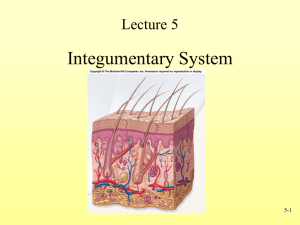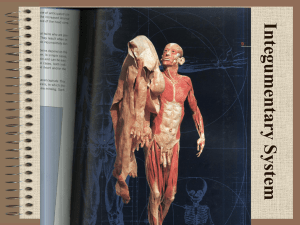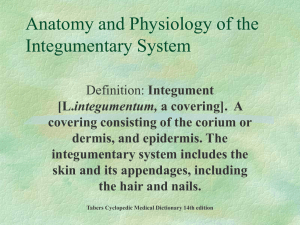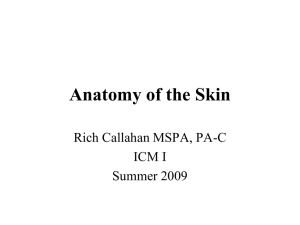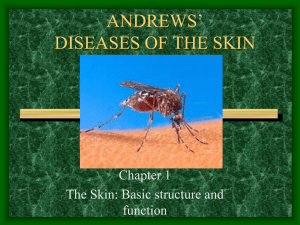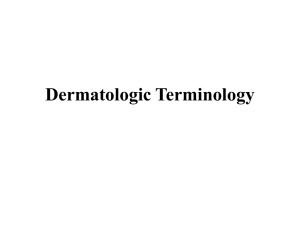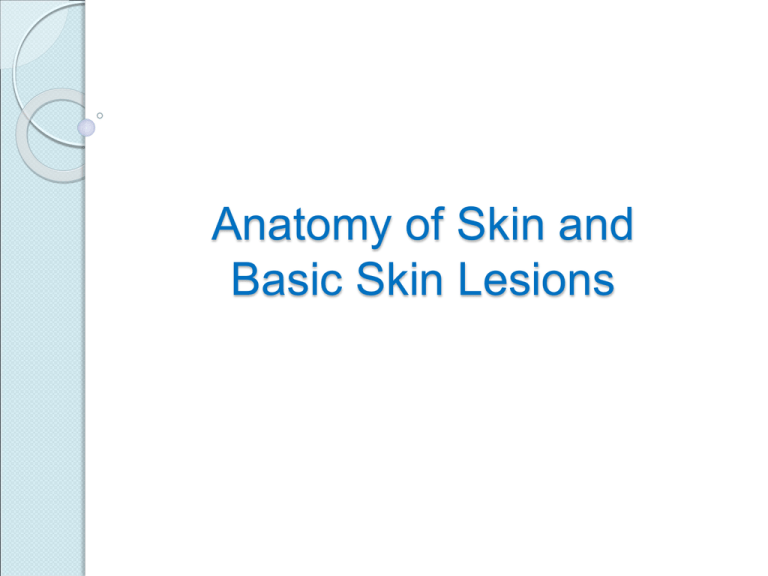
Anatomy of Skin and
Basic Skin Lesions
Layers of Skin
Epidermis
- stratum basale
- stratum
spinosum
- stratum granulosum
- stratum corneum
Dermis
- papillary dermis
- reticular dermis
Subcutaneous Fat
Types of Cells in Epidermis
Keratinocyte
Melanocyte
Langerhans cell
Merkel cell
Strata of Epidermis
Stratum basale: Cuboidal / columnar cells;
large oval nuclei, dense basophilic cytoplasm
Stratum spinosum (spinous/prickle cell layer):
Polygonal cells with delicate processes,
desmosomes connect adjacent keratinocytes
Stratum granulosum: Flattened diamond
shaped cells filled with coarse basophilic
keratohyaline granules
Strata of Epidermis
Stratum lucidum :
Clear layer found in palms and soles
Stratum corneum :
Flat, anuclear, eosinophilic corneocytes
Dead layer shed during epidermal turnover
Epidermal turnover/ transit time:
Time taken for a cell to pass from basal layer
to surface of skin.
52-75 days (normal skin)
Melanocyte
Neural crest derived cells
Dendritic cells that synthesize and secrete
melanin containing organelles called
melanosomes
Located in basal layer; 1:10 ratio
Epidermal Melanin Unit: A single melanocyte
supplies melanosomes to 36 keratinocytes(1:36)
Melanosomes vary in number and size
according to skin type
Melanocyte
Melanin formed through mediation of tyrosinase
and DOPA
Function of melanin
- Impart colour to skin and hair
- Protect the skin from UV radiation
- Biochemical neutralizer of toxic, free radical
oxygen derivatives
Langerhans cell and Merkel cell
Langerhans cell
- Type of macrophage
- Role in various immune processes like allergic
contact dermatitis, immune tolerance,
surveillance against neoplasia
Merkel cell
- Neuritic cells
- Touch receptors
- Detect mechanical deformities of epidermis
Functions of Epidermis
Cornification
Barrier function
Permeability
Maintenance of fluid and electrolyte balance
Thermoregulation
Pigmentation
Immune function
Sensory receptor
Vitamin D Synthesis
Dermis
Papillary dermis - thin zone beneath epidermis
Reticular dermis - thick zone which extends
from base of papillary dermis to the surface of
subcutaneous fat
Structure of dermis
•
•
Non-cellular connective tissue
Constituted of collagen, elastic fibers and
ground substance (mucopolysaccharides,
chondroitin sulphate, glycoproteins)
Embedded nerves, blood vessels, lymph
vessels, muscles and pilo sebaceous, apocrine
and eccrine units
Cellular contents include fibroblasts, mast cells,
histiocytes, Langerhans cells, lymphocytes and
eosinophils
Variation of thickness of skin
Difference of thickness of the skin is dependent
largely on dermal thickness, with the palms and
soles being thickest (1.5 mm) and thinnest in
the eyelids and post-auricular region (0.05
mm).
Children and elderly have thinner skin than
adults
Males have thicker skin than females
Dermo-Epidermal Junction
Consists of
- Basal lamina
- Lamina lucida
- Lamina densa
- Anchoring filaments
- Anchoring fibrils
- Dermal microfibril bundles
Functions of Dermo-Epidermal junction
Attachment of dermis to epidermis
Support to epidermis
Regulation of permeability
Autoantibodies to proteins in the dermoepidermal junction may be responsible
for vesiculobullous disorders
Embryology of skin
All constituents derived from ectoderm and
mesoderm
Ectoderm and mesoderm begin to proliferate and
differentiate at 4th week of intrauterine life
The specialised structures of skin, teeth, hair,
nails and glands begin to appear at this time
Epidermal Appendages
Hair follicles
Sebaceous glands
Apocrine glands
Eccrine glands
Hair
Types
- Lanugo
- Vellus
- Terminal
Sites of hair follicles
Found over the entire surface of the body except
palms, soles, glans penis, clitoris, labia minora,
mucocutaneous junction and distal portions of the
fingers and toes
Anatomy of hair
Longitudinal section
Infundibulum
Isthmus
Stem
Bulb
Cross section
Outer sheath
Inner sheath
- Henle’s layer
- Huxley’s layer
- Cuticle
• Cortex
• Medulla
Phases of hair growth
Hair cycle consists of three phases:
Anagen : Growing phase lasts for 2-10 years.
About 90% of hair are in anagen at a time.
Catagen : Involution phase lasts for 1-3 weeks.
About 1% hair are in catagen.
Telogen : Resting phase lasts for about three
months. About 10% hair are in telogen.
Telogen hair is shed and anagen hair replaces it.
Sebaceous Glands
Lipid producing holocrine glands
Arise from the hair follicle at the junction of the
infundibulum and the isthmus
Distributed all over the body except the palms
and soles; most numerous , large and
productive over the face and scalp
Mature at puberty and are stimulated by various
hormones
Sebaceous Glands
Consists of lobules of epithelial cells that
differentiate toward lipid producing cells in a
centripetal manner
Enlarged, vacuolated cells in the center of the
lobule disintegrate into an amorphous mass sebum
Major components of sebum: Triglycerides,
wax esters, squalene, cholesterol esters and
cholesterol
Eccrine Sweat glands
Thermoregulation
Entire surface of the body except the lips,
external ear canal and labia minora
Most concentrated in the palms and soles
Apocrine Sweat Glands
Vestigial sexual function
Axillae and anogenital regions
Mammary glands considered modified and
specialized type of apocrine glands
Blood / Lymphatic supply of skin
Extensive subdermal and dermal plexuses
Dermal plexus: Horizontal superficial and deep
plexuses, connected by vertical communicating
vessels
Cutaneous vasculature important in
thermoregulation
Cutaneous lymphatics parallels the blood supply
Skin innervation
Light touch: Merkel cells of the epidermis,
Meissner’s corpuscles in dermal papillae
Pressure: Pacinian corpuscles in deep dermis or
subcutaneous tissue
Pain: transmitted through naked nerve endings
located in the basal layer of the epidermis
Temperature:
- Krause bulbs detect cold, Ruffini end organs
detect heat
- Heat, cold and proprioception also located in
the superficial dermis
- Adjacent dermatomes often overlap, important in
local anaesthesia
Classification
Primary lesions
Secondary lesions
Special lesions
Basic Skin Lesions
Primary Skin Lesions
Macule
Vesicle
Patch
Bulla
Papule
Pustule
Plaque
Cyst
Nodule
Wheal
Secondary Skin Lesions
Scale
Ulcer
Crust
Scar
Excoriation
Fissure
Induration
Erosion
Atrophy
Lichenification
Special Skin Lesions
Burrow
Comedo
Milium
Poikiloderma
Telangiectasia
Target lesion
Macule
Definition: A circumscribed alteration in the
colour or texture of the skin
Types: Erythematous, hypopigmented,
hyperpigmented, depigmented, purpuric
Examples: café au lait macule, vitiligo
Erythema / Purpura
Erythema: Redness of the skin, blanches on
pressure and is due to vascular congestion or
increased perfusion. Eg: SLE, Rosacea
Purpura: Discoloration of skin or mucous
membrane, non- blanchable due to
extravasation of red blood cells. Eg: Vasculitis,
clotting disorders
Petechiae: 1-2 mm small purpuric lesions,
occurs in crops. Eg : clotting disorders
Ecchymoses: larger extravastions of blood.
Eg: post traumatic
Papule
Definition: A circumscribed palpable elevation,
less than 1 cm in diameter
Types: dome-shaped, flat-topped, umbilicated,
pedunculated
Examples: Warts, Molluscum
Plaque
Definition: An elevated area of skin, 1cm or
more in diameter; surface area is greater than
the height.
It may be formed by the extension or
coalescence of either papules or nodules
Examples: psoriasis, granuloma annulare
Nodule
Definition: A solid mass in the skin, which can
be observed as an elevation or can be palpated.
It is more than 0.5 cm in diameter.
The depth of a nodule differentiates nodules
from papules. The absolute size is probably not
very important.
Examples: furuncle, erythema nodosum
Vesicles and Bullae
Definition: Visible accumulations of fluid within
or beneath the epidermis. Vesicles are small,
less than 0.5 cm in diameter. Bullae are larger
and may be of any size above 0.5 cm in
diameter.
Examples: Herpes simplex, Eczema,
Pemphigus, Burns, Impetigo
Pustule
Definition: A visible accumulation of free pus. It
may occur in association with infection or may
be sterile
Examples: Bacterial / Candidial infections,
Psoriasis (sterile)
Wheal
Definition: An area of dermal or dermal and
hypodermal oedema, erythema and pallor;
which is evanescent
Examples: characteristic lesion of urticaria
Cyst
Definition: Any closed cavity or sac (normal or
abnormal) with an epithelial, endothelial or
membranous lining and containing fluid or
semisolid material
Examples: epidermal cysts, pilar cysts,
sebaceous cysts
Scale
Definition: Visible exfoliation of a flat plate or
flake of stratum corneum
Examples:
Furfuraceous - Pityriasis Versicolor
Ichthyotic, lamellar- Ichthyosis
Micaceous - Psoriasis
Collarette - Pityriasis rosea
Crust
Definition: Crusts consists of dried serum and
other exudates
Types: hemorrhagic crust (scab), purulent
Examples: Impetigo
Excoriation
Definition: Loss of skin substance produced by
scratching
Types:
- linear
- circumscribed
Examples: Acne excoree, Prurigo
Fissure
It is a linear crack in the skin, which may be
superficial or deep to the dermis
Erosion
Definition: A loss of whole part of epidermis,
which heals without scarring. It commonly
follows a blister
Examples: Impetigo
Pemphigus
Ulcer
Definition: A loss of epidermis and some parts of
dermis, may involve underlying tissues.
Examples: trauma, stasis ulcer
Scar
Definition: A replacement by tissue that has
been destroyed by injury or disease by fibrous
tissue
Types: atrophic
hypertrophic
cribriform
varioliform
pitted
Lichenification
Definition: The thickening of the epidermis and
to some extent of the dermis, pigmentation and
accentuation of skin markings,in response to
prolonged rubbing.
Examples: Lichen simplex chronicus
Induration
Definition: firm and thick skin due to dermal
involvement
Sclerosis
Definition: A diffuse or circumscribed induration
of the subcutaneous tissues. It may also involve
the dermis.
Sclerosis is better felt than seen
Examples: Scleroderma
Atrophy
Definition: A loss of tissue characterized by the
loss of normal skin markings
Types of atrophy: Epidermal, dermal,
subcutaneous, mixed
Loss of skin markings occur in epidermal
atrophy only
Burrow
Definition: A small tunnel in the skin that houses
a metazoal parasite
Examples: Scabies
Comedo
Definition: A plug of keratin and sebum in a
dilated pilosebaceous orifice
Types: open
closed
Examples: Acne
Telangiectasia
Definition: visible and permanent dilatation of
capillaries
Types: punctate, matt-like, linear, spider
Examples: Rosacea
Nail fold telangiectasias in systemic
sclerosis
Milium
Definition: A tiny white cyst containing
lamellated keratin
Milia are lined by epithelium
Poikiloderma
Definition: The association of cutaneous
pigmentation, atrophy and telangiectasia
Examples: Dermatomyositis
Target lesions
Definition: These are less than 3 cm diameter
and have 3 zones; a central zone of dusky
erythema or purpura, a middle paler zone of
oedema and an outer ring of erythema with a
well-defined edge.
The diameter of target lesions may not be
significant
Examples: Erythema multiforme
Alopecia
Definition: Loss of hair from a normally hairy area
Types: Scarring, Non-scarring
Examples: Alopecia areata, Androgenic alopecia
Patterns
Annular
Linear
Grouped
Discoid
Reticulate
Thank you





